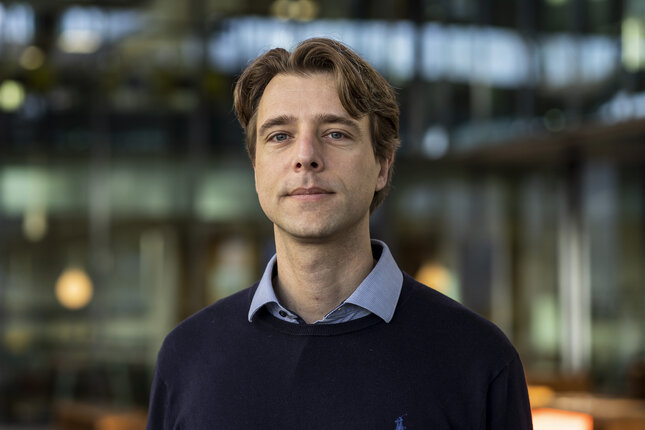ERC Consolidator Grant of 2 million euros for three TU/e researchers
The researchers are all involved in building a digital future that is both fast and energy-efficient

TU/e researchers Yoeri van de Burgt, Klaas-Jan Tielrooij, and Aida Todri-Sanial have each been awarded an ERC Consolidator Grant worth two million euros from the European Research Council (ERC). The researchers will use this money for research into organic computers, ultrafast components for wireless networks based on terahertz radiation, and developing a novel computing paradigm based on thermodynamics, respectively. We spoke to the three researchers about their plans for the coming five years.
Associate Professor Yoeri van de Burgt, working at the Department of Mechanical Engineering and institutes EAISI, EHCI, and ICMS, works on electronic systems that are nothing like the electronics in your laptop or cell phone. The heart of the devices in his lab are not made of the semiconductor silicon, but of organic materials that are also found in our bodies.
Moreover, this organic processor is more similar in design to the neural networks in our brains than to a classical computer chip. Van de Burgt now wants to connect such a processor to a biological environment consisting of nerve cells.
That connection to biological material is challenging, according to Van de Burgt. “We want to make a connection that transmits information to both sides, and that's tricky,” he says. “How do you measure signals from biological cells and pass them on to the processor? Moreover, we want this connection to be 'self-learning,' like the flexible connections between brain cells.”
The latter means that the strength of the coupling depends on previous signals that passed through it, but also on the presence of certain neurotransmitters, or signaling substances, in the biological environment.

Spikes and neurotransmitters
The platform the researchers are building for this project is several centimeters in size and consists of fluid channels as well as sensors made of so-called mixed conducting polymers that can conduct both electrons and charged ions.
“This processor responds to two types of signals,” Van de Burgt says. “The first type of signals are normal electrical signals - or spikes - from nerve cells. The second signal is neurotransmitters such as dopamine or serotonin, signaling substances that you also find in the brain. The concentration of these substances determines the strength of the learning part.”
Finally, the processor is given a task: the researchers connect a “soft” gripper to it. Not only do they want to control the gripper with electrical signals from the cells. The idea is that the organic processor will eventually “learn” to deal with the gripper and, for example, be able to apply just the right amount of force to grip a particular object.
The promise, according to Van de Burgt, is that in the future the technology could serve for personal prosthetic devices that are directly coupled to the body. This kind of organic computer could eventually do the same work locally, inside the body, much more energy-efficiently than an external classical computer.
The project is called “neuro-labs” and will consist of three PhD students and two postdocs.

The power of tetrahertz radiation
Not so long ago people used to only send short text messages to each other; now they talk via video call and send large files effortlessly. This development requires ever faster connections and processing of data. Associate Professor Klaas-Jan Tielrooij of the Department of Applied Physics and Science Education is laying the foundation for wireless electronic components that can keep up with this trend in the future.
New materials and new physics should enable compact transmitters and receivers that process trillions of signals per second. These optoelectronic components use terahertz radiation to send and receive information. In theory, they are many times faster than the components now found in wireless communication networks.
Currently, terahertz components for wireless communications are often inefficient and quite costly. This is in contrast to infrared and optical light, which are widely used in fiber optics. Tielrooij will use extremely thin materials, such as graphene and other so-called quantum materials, which are only one or few atoms thick.
The dynamics of electrons
Essential for a good terahertz transmitter or receiver is an efficient conversion of light of another wavelength to terahertz radiation, and vice versa, and to electrical signals. To this end, Tielrooij is one of the first to apply a design strategy based on the so-called ultrafast thermodynamic properties of materials.
“Existing techniques mostly rely on an interaction between light and the charge of electrons in the material. If you can also use the dynamics of electron temperature then this conversion can be much more efficient,” he says. You can think of this electron temperature as the amount of energy of the electrons.
According to Tielrooij, the components he is developing will soon end up not only in components for wireless networks. Terahertz radiation is also suitable for safely scanning people and suitcases at airports, for example. And it could be used to perform medical scans to detect tumors, for example.
“The terahertz regime is not as developed compared to other wavelengths. It is important that we catch up, because there are many possible applications,” he says.
The project is called “Engineering QUAntum materials for TErahertz applications” (Equate) and consists of three PhD students and two postdocs.

Self-organizing neural networks
Aida Todri-Sanial, professor of Integrated Circuits in the Department of Electrical Engineering and EAISI, will develop a novel computing paradigm inspired by thermodynamic principles. By applying this to artificial neural networks in the lab this could lead to computers that can solve computationally hard problems in an energy-efficient way.
Todri-Sanial has been modeling and building artificial neural networks in the lab for many years. These are based on electrical oscillators on a chip that uses very little power. Now she wants to give these so-called oscillatory neural networks the ability to learn, similar to how the brain works. This requires rethinking the building blocks of such a system: to enable self-organization, reconfigurability, adaptability, and evolution, something that has not been done before in artificial neural networks.
Efficient and stable
Traits like self-organization, adaptation, and evolution are based on thermodynamics principles, which drive a system to evolve and adapt in an energy-efficient way towards stable configurations. These configurations represent the solution of the task that is given to the system. Self-organization is frequently observed in nature but not yet in our computing systems, Todri-Sanial says.
“In this project, I want to design a computing architecture that self-organizes to solve problems via collective dynamics of coupled oscillators. To do so, we will first develop computing models based on thermodynamics and then design analog integrated circuits for implementing a thermodynamic-inspired computing architecture.”
In the future self-organizing neural networks could solve problems that are typically hard for classical computers, like predicting the weather, find the shortest route between two points on a map or calculating exactly how two molecules will bind. The latter could be very useful in developing new medicines. The research could also lead to more efficient learning strategies for artificial intelligence.
The project “Thermodynamic-inspired computing with oscillatory neural networks” (THERMODON) will consist of three PhD students and three postdocs.
ERC Consolidator Grants
The ERC’s mission is to encourage the highest quality research in Europe through competitive funding and to support frontier research across all fields, based on scientific excellence. ERC grants allow Europe's brightest minds to identify new opportunities and directions in any field of research and catalyze new and unpredictable scientific and technological discoveries.
The ERC Consolidator Grants are awarded to outstanding researchers of any nationality and age, with at least seven and up to twelve years of experience after a PhD, and a scientific track record showing great promise.
Latest news


![[Translate to English:] [Translate to English:]](https://assets.w3.tue.nl/w/fileadmin/_processed_/e/0/csm_BvOF%202019_1031_BHF%20license%20TUe%20ILI%20copy_8a50884392.jpg)